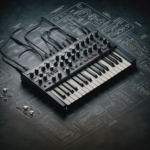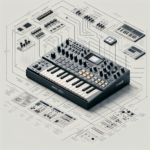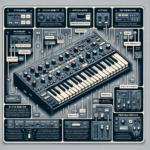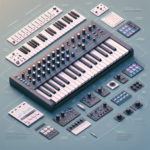Alesis Q49: Comprehensive Guide to Features, Setup, and Performance
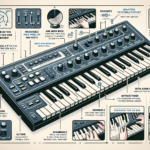
Introduction
The Alesis Q49 is a versatile and user-friendly MIDI controller designed to meet the needs of both beginners and seasoned musicians. This 49-key controller offers a range of features that make it an excellent choice for music production, live performances, and studio sessions. Targeted at musicians, producers, and DJs, the Alesis Q49 provides a seamless interface for controlling virtual instruments and software synthesizers.
Alesis, a well-known brand in the music industry, has a reputation for producing high-quality, affordable musical equipment. With a focus on innovation and user experience, Alesis has become a trusted name among musicians and producers worldwide.
Key Features Overview:
- 49 full-size, velocity-sensitive keys
- USB-MIDI and traditional MIDI Out
- Pitch and modulation wheels
- Assignable data slider
- Octave up and down buttons
- Plug-and-play setup
Design and Build Quality
Physical Design
The Alesis Q49 boasts a sleek and compact design, making it an attractive addition to any studio setup. Measuring approximately 32.28 inches in length, 7.48 inches in width, and 2.36 inches in height, the Q49 is designed to fit comfortably on a desk or in a studio rack. The controller is lightweight, weighing just around 4.6 pounds, which makes it easy to transport.
Portability
Thanks to its lightweight and compact design, the Alesis Q49 is highly portable. Musicians who need to move between different studios or perform live will find it easy to carry this controller without much hassle. Its USB-powered functionality further enhances its portability, eliminating the need for an external power supply.
Durability
The build quality of the Alesis Q49 is robust, with a solid plastic chassis that can withstand regular use. The keys are well-constructed and provide a satisfying tactile response. While it may not be as rugged as some high-end controllers, it offers excellent durability for its price range.
Setup and Configuration
Initial Setup
Setting up the Alesis Q49 is straightforward. Follow these steps to get started:
- Unbox the controller and connect it to your computer using the provided USB cable.
- Power on your computer and wait for it to recognize the new hardware.
- Open your preferred Digital Audio Workstation (DAW) and configure the MIDI settings to recognize the Alesis Q49.
Software Installation
The Alesis Q49 is designed to be plug-and-play, meaning it does not require any additional drivers for most operating systems. However, it is recommended to check the Alesis website for any firmware updates or additional software that may enhance your experience.
Compatibility
The Alesis Q49 is compatible with a wide range of operating systems and DAWs:
- Operating Systems: Windows 7 and later, macOS 10.7 and later
- DAWs: Ableton Live, FL Studio, Logic Pro, Pro Tools, Cubase, and more
Features and Functionality
Key Features
The Alesis Q49 comes equipped with 49 full-size, velocity-sensitive keys that provide a responsive and expressive playing experience. The pitch and modulation wheels offer additional control over your sound, while the assignable data slider allows for real-time parameter adjustments.
Customizability
Users can customize the Alesis Q49 to suit their specific needs. The controller supports MIDI mapping, allowing you to assign different functions to the keys, wheels, and slider. This flexibility makes it easy to tailor the controller to your workflow.
Unique Functions
One of the standout features of the Alesis Q49 is its octave up and down buttons, which extend the range of the keyboard. This feature is particularly useful for musicians who need access to a broader range of notes without switching instruments.
Integration with DAWs
The Alesis Q49 integrates seamlessly with popular DAWs like Ableton Live, FL Studio, and Logic Pro. The plug-and-play functionality ensures that the controller is recognized immediately, allowing you to start making music without any complicated setup processes.
Advanced Features
While the Alesis Q49 is a straightforward controller, it does offer some advanced features such as velocity sensitivity, which allows for dynamic playing. However, it lacks more advanced features like aftertouch, arpeggiators, and chord modes, which are found in higher-end models.
Performance
Latency and Responsiveness
The Alesis Q49 performs admirably in terms of latency and responsiveness. The keys are responsive, and there is minimal latency when connected via USB. This makes it suitable for both studio recording and live performances.
Real-World Usage
In practical scenarios, the Alesis Q49 proves to be a reliable and efficient MIDI controller. Whether you’re composing in a studio or performing live, the Q49 offers a smooth and intuitive experience. Its portability and ease of setup make it a favorite among musicians who need a dependable controller on the go.
User Experience
User feedback for the Alesis Q49 is generally positive. Many users appreciate its simplicity, portability, and affordability. The velocity-sensitive keys and assignable controls are frequently highlighted as standout features. However, some users have noted the lack of advanced features as a drawback.
Applications and Use Cases
Beginner vs. Professional Use
The Alesis Q49 is well-suited for both beginners and professionals. Beginners will find it easy to set up and use, while professionals will appreciate its portability and reliable performance. However, advanced users may find the lack of certain features limiting.
Studio Use
In a studio environment, the Alesis Q49 excels as a MIDI controller for music production and recording. Its velocity-sensitive keys and assignable controls make it a versatile tool for creating and manipulating sounds.
Live Performance
The Alesis Q49 is also a solid choice for live performances. Its lightweight design and USB-powered functionality make it easy to transport and set up on stage. The pitch and modulation wheels, along with the octave buttons, provide additional control during live sets.
Specific Genres
The Alesis Q49 is versatile enough to be used across various genres of music. It performs particularly well in electronic music genres like EDM and hip-hop, where MIDI controllers are often used to trigger samples and control virtual instruments. However, it is also suitable for classical and other genres that require expressive playing.
Pros and Cons
Pros:
- Affordable price
- 49 full-size, velocity-sensitive keys
- Lightweight and portable
- Easy to set up and use
- Assignable data slider
- Octave up and down buttons
Cons:
- Lacks advanced features like aftertouch and arpeggiators
- Build quality may not be as robust as higher-end models
- Limited customizability compared to more advanced controllers
Common Issues and Troubleshooting
Known Issues
Some users have reported issues with the keys becoming less responsive over time. Additionally, there have been occasional reports of connectivity problems when using the traditional MIDI Out port.
Troubleshooting Tips
- If you experience connectivity issues, try using a different USB port or cable.
- Ensure that your DAW is configured correctly to recognize the Alesis Q49.
- If the keys become less responsive, try cleaning them gently with a soft cloth.
Customer Support
Alesis offers reliable customer support for the Q49. Users can access online resources, including FAQs and user manuals, on the Alesis website. Additionally, Alesis provides email and phone support for more complex issues.
Comparisons with Similar Controllers
Competitor Comparison
When compared to similar models from other brands, the Alesis Q49 holds its own. For instance, the M-Audio Keystation 49 offers similar features but at a slightly higher price point. The Akai MPK Mini MK3, while more compact, offers additional features like drum pads and an arpeggiator but has fewer keys.
Feature Comparison
The Alesis Q49 stands out for its affordability and simplicity. While it may lack some advanced features found in higher-end models, it offers a solid set of features for its price range. Its 49 full-size keys and assignable controls make it a versatile choice for various musical applications.
Conclusion
Summary
The Alesis Q49 is a reliable and affordable MIDI controller that offers a range of features suitable for both beginners and professionals. Its 49 full-size, velocity-sensitive keys, assignable controls, and portability make it a versatile tool for music production, recording, and live performances.
Who Should Buy This?
The Alesis Q49 is ideal for musicians, producers, and DJs looking for an affordable and easy-to-use MIDI controller. It is particularly well-suited for beginners who need a straightforward controller to get started with music production. However, professionals will also appreciate its portability and reliable performance.
Final Thoughts
Overall, the Alesis Q49 offers excellent value for its price. While it may lack some advanced features, it provides a solid set of functionalities that make it a versatile and reliable choice for various musical applications. Whether you’re a beginner or a seasoned musician, the Alesis Q49 is a worthy addition to your setup.
FAQ
Is the Alesis Q49 compatible with my DAW?
The Alesis Q49 is compatible with most popular DAWs, including Ableton Live, FL Studio, Logic Pro, Pro Tools, and Cubase.
Do I need to install any drivers to use the Alesis Q49?
No, the Alesis Q49 is designed to be plug-and-play and does not require any additional drivers for most operating systems.
Can I use the Alesis Q49 with an iPad?
Yes, you can use the Alesis Q49 with an iPad using a USB to Lightning adapter. Ensure that your iPad supports MIDI controllers.
Does the Alesis Q49 have aftertouch?
No, the Alesis Q49 does not have aftertouch. It does, however, offer velocity-sensitive keys.
How do I assign functions to the data slider?
You can assign functions to the data slider using MIDI mapping in your DAW. Refer to your DAW’s user manual for specific instructions on MIDI mapping.
Where to Buy
The Alesis Q49 can be purchased from various retailers, including major music stores like Guitar Center, Sweetwater, and online marketplaces such as Amazon and eBay. Be sure to check for the best prices and any available warranties or return policies.

